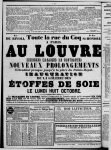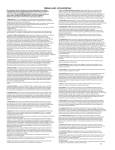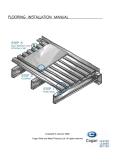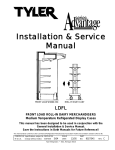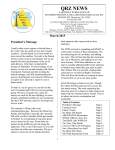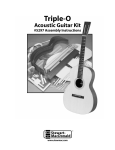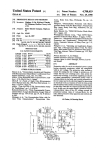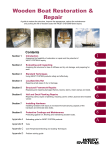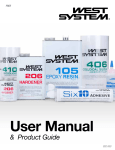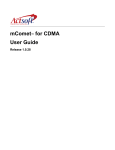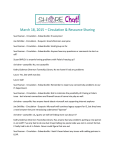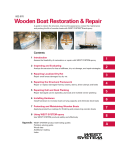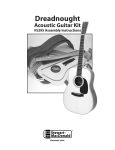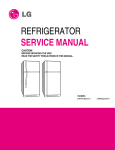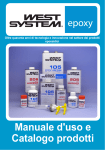Download Number 10, Fall 1998 - WEST SYSTEM Epoxy
Transcript
® EPOXYWORKS ® Special issue Strip Plank Construction BUILDING, RESTORATION & REPAIR with EPOXY Number 10 n Winter 1998 EPOXYWORKS Number 10, Winter 1998 Photo: J R Watson 1 In this issue 1 Strip construction 3 Types and sources of strip plank material 5 How tough are they? 6 Planking basics 8 Making tight bends 8 Edge gluing fixtures 9 Holding strip planks in place 10 Edge fastening 11 Start off simple 14 Panel warping 15 Building a ladder to the heavens 20 How to make a solar filter 21 Getting the clearest fiberglass finish 22 Bear Mountain Boat Shop EPOXYWORKS Editor Grace Ombry Graphics Michael Barker Assistant Kristen Lore Contributing Editors Jim Derck, Brian Knight, Bruce Niederer, Roy Oliver, Tom Pawlak, J.R. Watson EPOXYWORKS is published twice a year by Gougeon Brothers, Inc., P.O. Box 908, Bay City, MI 48707-0908 USA. ©1998 by Gougeon Brothers, Inc. Reproduction in any form, in whole or in part, is expressly forbidden without the written consent of the publisher. EPOXYWORKS, Gougeon Brothers, WEST SYSTEM,105, 205, 206, 207, 209, Episize, Scarffer, PRO-SET and Microlight as used throughout this publication, are trademarks of Gougeon Brothers, Inc. We welcome your comments and suggestions about EPOXYWORKS, as well as tips, techniques, and news of interesting projects completed. EPOXYWORKS, P.O. Box 908, Bay City, MI 48707-0908. E-mail: [email protected] WEST SYSTEM product and technical information is available on the web at: www.westsystem.com or by calling 989-684-7286. EPOXYWORKS Number 10, Winter 1998 Strip Construction An Overview By J.R. Watson We feature strip construction in this edition of Epoxyworks® because of the wide range of projects we have seen over the years and the many we support on a daily basis. In most peoples minds, the beautiful, well-built stripper canoe almost defines the technique. But, we've also seen strip mailboxes and ships, cars and cradles, airplanes and artwork. The versatility of strip construction is well matched to the versatility of WEST SYSTEM® epoxy. We receive many questions about strip construction. We hope this Epoxyworks answers many of your questions and opens up new ways to think about and use this most versatile of construction methods. Strip construction is a building method that uses long, narrow pieces (strips) of material joined on their edges to produce a continuous surface, forming the skin of a structure. It is usually supported by frames, bulkheads, fabrics or veneers running perpendicular to the strips. Although simple, flat structures can be produced this way, strip construction is ideal for rounded, or compound curved surfaces such as boat hulls. It has been around for many years and has evolved into many variations. Strip planking Strip planking, as it is most commonly known, began as a method for planking round bottomed boats that was quicker and easier than carvel planking. It eliminated much of the spiling, steam bending and caulking that went with carvel construction. It became a more widely used method to build boats when water-proof adhesives became available. Resorcinol glues were used with edgenailing of narrow (often square in section) planks over frames. The nails held the planks as the adhesive dried, and were left in place. They offered some cross-grain reinforcement along with the frames. Epoxy took strip planking a step further because it could fill gaps better than resorcinol and required only contact pressure during cure. Everything from rowboats to 250-ton commercial fishing boats are built using strip plank construction. Strip plank laminating Strip plank laminating combines strip planking and cold molding or laminating. Strip planking forms the first layer and is covered by layers of veneer, allowing interior framing to be reduced or eliminated. Strip plank laminating, in a wide range of variations, has been used over the years most often for larger boats. 1 Veneers are added to the strip planked layer usually in a double diagonal pattern (±45°) to provide cross-grained reinforcement. As more layers are added, the need for interior frames is reduced. Many boats in the 20' to 35' range are monocoque structures, for which only temporary frames are needed. Compared to a laminated veneer hull, strip construction offers significant advantages. Both methods can be used to build rigid monocoque structures with frameless interiors, but strip plank laminating requires much less labor. Laminating veneer is a more difficult process requiring multiple layers of veneer, each of which must be spiled, bonded and fixed in place until the adhesive cures. The laminated hull is built over a temporary mold which can be as difficult to build as the actual boat. Strip plank laminating uses fewer veneers, the hull shape can be quickly established and only part of the mold is discarded. Some of the largest wood/epoxy boats ever built use strip plank laminating. The 124' sloop featured in the last Epoxyworks, and the 65 meter (213') barque featured on page 23 of this issue are both variations of the strip plank laminating method. Both use double diagonal layers over strip planking, with a second strip plank layer on the exterior. At this scale, however, the diagonal layers are at least 38" thick and technically not what you would call veneers. Hulls of this size still rely on internal frames and bulkheads for cross-grain support. Strip composite construction Strip composite construction is another variation of strip planking. Strips are joined as with the previous variations, but all cross-grain reinforcing is done with a layer, or layers of fabric, bonded with epoxy on the inside and outside. This results in a stiff, strong, frameless, lightweight structure. With single layers of fabric, the epoxy and fiberglass cure clear, allowing the wood’s natural beauty to show. A popular example of strip composite is the stripper canoe (Cover photo). They are usually built of ¼"-thick cedar strips, planked over temporary frames, with 4 oz or 6 oz woven glass fabric inside and out. Though used mostly for smaller boats, strip composite construction is not limited to small craft or to standard boat shapes. Larger cusEPOXYWORKS Number 10, Winter 1998 tom racing craft, such as the formula 40 trimaran Adrenalin, were constructed this way. Because of its rounded topsides, the hull was built in halves in female mold frames. It used unidirectional carbon fiber reinforcing laid at 90° to the 38" thick cedar strips. Applying unidirectional carbon fiber to the inside of Adrenalin's cedar strip hull. There are many variations of reinforcing materials, and many choices of strip composites: When higher density materials such as mahogany, cedar and pine are joined, they contribute to the structure. They provide tensile and compressive strength along the grain, as well as shear strength through their thickness. They are considered an “active core.” Such a core may require minimal reinforcement, depending on grain strength and how the composite will be used. In contrast, an “inactive core” (such as foam strips) is used only as a base for the reinforcing skins. An inactive core gives the structure its shape, but doesn’t add to its strength. A hybrid, DuraKore™, combines balsa core with wood veneer skins in a strip form. One of the advantages of strip construction is the ability to build compound shapes quickly. The strips are typically placed over mold frames that define the structure’s shape. Most shapes can be built in strip construction, although the more spherical shapes are limited by the strips ability to bend in two directions. Strip construction opens up a wide range of building possibilities. We hope the articles within this issue give you some ideas of how strip construction can benefit you in your next project, whether it’s a clipboard, a canoe or a sailing ship. n 2 Types and sources of strip plank material By Brian Knight Strip materials STRIP PROFILES Rectangular/Square Illust 2 Bead and cove Illust 3 Ship lap Illust 4 Tongue and groove Modern strip composite construction uses narrow strips of wood or foam to make a low density core material. These strips are easy for one person to handle and are readily assembled into complex shapes. However, this assembled structure does not have much strength until it is covered inside and out with a high density fiber reinforced skin—usually fiberglass cloth. The process of making and fitting the narrow strips together is more time consuming than bending a sheet of plywood, but the technique allows for more creativity in the design. Strips for strip planking are available premade or you can manufacture them yourself. The strips can have a wide range of density and geometry. In this article, I will discuss commonly used strip materials and geometry, and sources for and about strip planks and strip plank construction. Wood and foam are the most commonly used materials for strip composite, but any material that will machine easily and conform to the required shape is fair game. Wood, by far the most popular material, is an “active core” that provides longitudinal strength and stiffness. The beauty of wood/epoxy construction is that you do not need prime, endangered or environmentally controversial woods. Foam strips make an “inactive core” and do not provide directional strength like wood does. They may need stronger skins to carry the same load that wood strips do. Below are some commonly used materials and their density. Material Wood Cedar, redwood Mahogany, Douglas fir Ash, White oak Foam DuraKore™ strip Speed Strip™ (wood) Density 23 lb./cubic ft 32 lb./cubic ft 40 lb./cubic ft 2 to 6 lb./cubic ft 15 lb./cubic ft 23 to 40 lb/cubic ft The strips are available in a variety of profiles. Among these are rectangular or square cross section, bead and cove, ship-lap and tongue and groove (left). EPOXYWORKS Number 10, Winter 1998 Advantages of each profile In tight bends, the strips tend to twist out of plane between the mold stations. The tongue and groove, the bead and cove, and to a lesser degree the ship-lap, use “nesting” geometry to keep the planks aligned between mold stations. Bead and cove leave no gaps on the outside of the hull. Rectangular cross section shapes are easy to manufacture on a table saw. Disadvantages of each profile Rectangular strips require support between stations to keep them aligned with the previously applied strip—especially in tight curves. There are a variety of methods to accomplish this. See Edge fastening, page 10. Rectangular strips leave a gap on the outside of a curve, which needs to be filled. Beveling eliminates the need for filling the gap, but it requires a great deal of skill to make a perfect bevel the entire length of a plank. The tongue and groove and the bead and cove require special cutters to manufacture the edge. DuraKore™ and Speed Strip™ DuraKore strip is made of end grain balsa sandwiched between 116" hardwood veneer. It is available in strips 38" to 1" thick, ¾" to 1¾" wide and 8' long. The ends are finger jointed so no scarfing is necessary to make long strips. It is rectangular in cross section and its main advantage is low weight and its ability to provide some longitudinal strength. Speed Strip is wood that is machined with a special tongue and groove profile. There is just enough clearance between the tongue and groove to allow the planks to rotate slightly. The product literature states that no scarfing is needed to make long planks. The tongue/ groove geometry of the adjoining planks is enough to reinforce the butt joints. Speed Strip is available in most wood species. Standard sizes range from ¼" × ¾" to 1¾" × 2¾"—lengths from 10' to 18'. 3 Making your own strips Many people decide to manufacture the strips themselves. For a large project, the process can get tedious. The following suggestions will make the job go more smoothly. Make enough material. When figuring how much stock to buy, make allowance for material lost when machining. If you are making ¼" thick strips, up to 50% of the original material is turned into saw dust when you mill it, depending on the thickness of your table saw blade. Thicker strips result in less waste. a tilted position. Use feather boards to hold work against the fence and down to the table. Finish machining the strips as quickly as practical. The longer the job takes, the more likely “gremlins” will show up in the dimensions of the strips. Cut wood strips from the edge of slab sawn wood. A flat grain board is cheaper than vertical grain boards and when you saw a strip from the edge, it yields vertical grain strips. Vertical grain is dimensionally stable and easier to finish than flat grain. Calculate the number of strips carefully and add 10% or so more. We all make mistakes and it is important to have additional stock available. Natural-finished projects require more wood to allow for color-matching the strips. The fussier you are, the more material you’ll need. With few exceptions you will have to scarf the strips to make them long enough to build your project. Make allowance for material lost when making scarf joints. It is generally easier, faster, and more precise to scarf the parent material before sawing the strips. You will spend less time making each joint and it eliminates the “doglegs” that can result if the wood is not perfectly aligned when the scarf is assembled. There are, however, situations where the color or grain orientation of the strip may be important and you may have to scarf individual planks. Cut all the strips using the same machine set-up. One setup makes all the dimensions consistent which is very important during assembly and fairing. Make the set-up as solid and rigid as possible. You do not want vibration or pressure to move the saw fence or vibrate the saw blade to When figuring the length of the strip material, It also helps to make the planks a foot or so longer than they need to be. When you are trying to force a plank into position, it is nice to have the extra length for leverage. Allow for the extra length in your calculations. n Machining edge treatments creates additional waste. For example, if you want tongue and groove on a strip that is 1½" wide, you will have to start with a strip that is 1¾" wide because the tongue requires ¼" of extra stock. Sources Bead and cove cutters for making ¼" strips Jesada Tools, Oldsmar (Tampa), FL, 800-531-5559 Cascade Tools Inc., PO Box 3110, Bellingham, WA 98227, 360-647-1059— ¼" flute-C1378, ¼ " bead-C1379. MLCS Ltd., PO Box 4053, Rydal, PA 19046, 800-533-9298 Speed Strip and custom mill work Maritime Wood Products, 3361 S.E. Slater Street, Stuart, FL 34997, 800-274-8325 Bead and cove foam ATC Core-Cell, 1015 Clinton Street, Buffalo, NY 14206, 716-836-1943, fax 716-836-23 Duracore—for dealer, contact Marine Department, Baltek Corporation, P.O. Box 195, Northvale, NJ 07647-0195, 201-767-1400, www.baltek.com Pre-shaped strips Anchor Hardwoods, 18 Covil Av., Wilmington, NC 28403, 910-3929888—Strips available in white cedar, Philippine mahogany, also marine plywood and exotic hardwoods Books Building a Strip Canoe, Gil Gilpatrick. Delorme Publishing CO., Amazon.com—Plans for 8 canoes included in book. Boatbuilding with Baltek DuraKore, David G. Brown, International Marine Publications, PO Box 220, Camden ME, 800-822-8158— Working with DuraKore, epoxy and fiberglass, good construction tips. KayakCraft, Canoecraft, Ted Moores, Bear Mountain Boat Shop, P.O. Box 191, Peterborough, Ontario, Canada K9J 6Y8, EPOXYWORKS Number 10, Winter 1998 877-392-8880, www.bearmountainboats.com, —Fine woodstrip kayak and canoe construction with designs and detailed instructions. Featherweight Boatbuilding, "Mac" McCarthy, WoodenBoat Books, P.O. Box 78, Naskeag Road, Brooklin, ME 04616—Instruction and patterns for building the Wee Lassie canoes. The Gougeon Brothers on Boat Construction, Gougeon Brothers, Inc., P.O. Box 908, Bay City, MI 48707, 866-937-8797—Working with epoxy and wood using, strip plank and other building techniques. Other book titles Rip, Strip & Row, The Stripper’s Guide to Canoe Building, The Strip-Built Sea Kayak 4 How tough are they? By J.R. Watson Once I went over a small falls in my stripper kayak. At the bottom was broken concrete with rebar in it. I clenched my teeth as the little kayak ground over it—hoping I’d built it tough enough. Fortunately, when I pulled to the bank to inspect the damage, there were only superficial scrapes. Since then, we have conducted proper tests to help estimating strip plank scantlings. We evaluated and compared the stiffness and strength of laminates of different wood core thicknesses, numbers of glass layers and glass weights. The results show how to build strength and stiffness into stripper style hulls and suggest appropriate scantlings for small craft Glass fabric is used in strip composite construction to supply cross grain strength to wood planking. In traditional building methods, closely space ribs serve this function. While one layer of cloth on each side of ¼" planking is appropriate for a canoe, it’s inadequate for larger hulls. Three good ways to increase strength and stiffness are, increase plank thickness, add more layers of reinforcing fibers, or use stiffer (higher modulus) reinforcing fibers. Panel thickness cedar strip Fiberglass schedule Weight ounces/sq. ft. Inches of deflection Pounds to failure 3/16" 1 layer 4 oz 6.5 .85 3/16" 2 layers 4 oz 8.8 .82 162 309 3/16" 1 layer 6 oz 8.0 .73 214 3/16" 2 layers 6oz 10.6 .90 500 1/4" 1 layer 4 oz 9.0 .45 150 1/4" 2 layers 4 oz 10.3 .70 375 1/4" 1 layer 6 oz 9.8 .49 221 1/4" 2 layers 6oz 12.3 .58 450 5/16" 1 layer 4 oz 10.6 .43 188 5/16" 2 layers 4 oz 12.6 .66 499 5/16" 1 layer 6 oz 11.6 .48 300 5/16" 2 layers 6oz 14.1 .44 500 3/8" 1 layer 4 oz 12.7 .42 250 3/8" 2 layers 4 oz 14.1 .66 675 3/8" 1 layer 6 oz 13.1 .32 298 3/8" 2 layers 6oz 15.4 .51 823 5/32" 1 layer 4 oz 8.5 1.47 211 7/32" 1 layer 4 oz 10.9 1.01 325 1/4" 1 layer 4 oz 12.8 .79 429 5/32" no glass 6.9 1.60 45 7/32" no glass 9.1 1.20 149 1/4" no glass 10.7 .63 225 marine plywood EPOXYWORKS Number 10, Winter 1998 To measure the effects of these variables, we subjected strip planked 12" × 12" test panels to high loads over a short time until the panels broke. We constructed 16 western red cedar/glass samples, using WEST SYSTEM® epoxy to bond the fiberglass fabric to the strip planked panels, using normal wet lay-up procedures. We let the epoxy cure thoroughly at about 60°F. We also built seven panels using marine grade plywood for comparison. We tested four thicknesses of cedar (316", ¼", 5 16" and 38") with both one and two layers of two weights of woven glass fabric (4 oz and 6 oz). We accurately weighed the samples. Next, we applied a three-point bending load on each panel with our MTS machine. The machine exerted loads parallel to the grain on the cedar samples, and parallel to the face grain on the plywood panels. We measured and recorded the loads exerted in pounds, and inches of deflection at specific points until panel failure. The ramp (rate of pressure applied) was selected for relatively short duration. The chart shows stiffness as “inches of deflection” at failure and strength as “pounds to failure.” Marine plywood of standard sizes used in small boat construction (with and without fiberglass cloth) is listed on the bottom of the chart as the known quantity for comparison. As expected, the panels became heavier as we added fiberglass cloth and epoxy. However, surprisingly little weight was gained relative to the increase in strength and stiffness. Data indicates that increasing both the number of layers of cloth and the thickness of the wood core will increase the overall strength of the wood strip structure without adding much weight. We found that ¼" cedar between layers of 6 oz glass cloth, the proven schedule for canoes, failed when subjected to a load of 221 lb. An additional layer of 6 oz fiberglass, as might be applied to a canoe’s bottom, increased the failure point by over 100% (to 450 lb), but added just 25% more weight (2.5 oz/square foot). The numbers don’t adequately convey just how much energy it takes to cause failure. You’d have to be in the laboratory when it happens to fully appreciate it. The MTS test machine applies force silently and nearly invisibly (up to 100,000 lb). At the moment of failure, there is a sound like a rifle shot, then a puff of cedar dust and pulverized glass. Examining this data, we may develop practical ways to use wood strip construction. We hope it benefits those who are considering using this nice building method. A good source of information on this subject is the Scantlings Rule for Sheathed Strip Construction from MacNaughton Yacht Designs, P.O. Box 190, Eastport, Maine 04631, 207-853-6678 n 5 Planking basics Strip technique Staff article Typical canoe mold Strip planking, strip plank laminating, and strip composite may be different methods of construction but they have in common the process of installing strips over frames that define the structure’s shape. These are general guidelines describing the process. First, the mold A typical boat hull mold calls for lofted profiles of the hull at regular intervals, or stations, along the length of the hull. These profiles may be temporary frames (to be removed after the stripped shape is reinforced), or they may be a mixture of temporary frames, permanent frames, bulkheads or other components. In larger boats, the keel, stem, shear clamp and transom are often incorporated within temporary molds to become part of the permanent hull. In small boats, these things are most often added after the planking is finished. Although most boat hulls lend themselves to male molds, in some instances, there is an advantage to stripping a shape inside a female mold. For example, the main hull of the Formula 40 trimaran Adrenalin is rounded top and bottom. This made it more convenient to build in left and right halves in female molds. Much of the interior components were installed before the halves were glued together—much like building a plastic model airplane fuselage. The telescope in the article on page 15 is also cylindrical and was built in halves and glued together. Align and plumb frame centerlines Stem to become part of hull Evenly spaced mold stations Plywood or particle board mold frames Strongback align and plumb the centerlines of all the frames. Use a stiff batten to check for fairness of the mold frames and any permanent members. Be sure that the bevels on all molds are fair. Hard spots may dent the planking as it is bent over the edge of a mold, which may show in the finished interior. To avoid bonding the planking to the temporary mold frames, cover the edges carefully with tape or strips of heavy plastic sheeting. Do not cover any permanent members you want to attach the planking to permanently. Protect everything else under and around the mold from epoxy drips, with tape or plastic sheeting. Plywood or particle board are most often used for temporary mold frames. For the difference in cost, ¾" material makes a stiffer, more accurate mold than ½", and gives you more meat to fasten the strips to. Plank layout On small boats the mold frames are rigidly attached to a stiff beam called a strongback that can be placed at a convenient working height. On large boats molds are rigidly attached to the floor. For some projects planking can be as simple as laying the first strip beginning on one side of the mold then laying strips edge to edge until you reach the other side of the mold. Planking thickness and the shape of the hull determine the standard spacing between mold stations. For ¼" thick planking (canoes), 12"–16" frame spacing is typical. For ½" thick planking, frame spacing is about 24", and for 1" thick planking, spacing may be 30" or more. If there are areas of tight, sharp curves which cannot be properly defined by the general station spacing, insert additional mold frames between the standard molds in these areas. Generally the girth of a boat is greater amidships than at the bow and stern. To accommodate this difference, strips are allowed to run out at the keel and the shear as they approach the ends of the hull. Unless the hull is particularly fat for its length, this technique presents no difficulties, provided that the planking is thin enough to bend easily edgewise as it arcs toward the sheer or keel. One of the critical parts of any strip construction project is accurately lofting and setting up the mold frames. Accurately mark the centerline of each frame and accurately EPOXYWORKS Number 10, Winter 1998 When you have completed this, you are ready to install the first strip. With a very full or rounded hull, there are two ways to reduce the severe edgewise bending of the strips. Which method you choose depends on how fat the hull is and on the aesthetics of the strip layout in a clear finished hull. 6 Master plank method Double run planking The goal is to locate the master plank about midpoint along the midship girth. This usually positions this first strip along the turn of the bilge. The strips on either side of this master strip will have the same degree of edgewise bending as you plank toward the keel or the shear. With this method, the hull surface is divided into two or more planking areas. The planks that run parallel to the keel are usually installed first. Planks are laid out from the keel to the bilge area where they are trimmed off in a fair curve. The shape of this curve should be designed to accommodate the second run of planking up to the shear without excessive bending and, for clear finished hulls, to look pleasing. To determine the location of the master plank, measure the profile of a number of frames along the hull and mark the mid-point between the keel and the sheer on these frames. Position a batten along these points and adjust it to achieve a fair curve, ignoring the last few frames at the bow and stern. By measuring up or down from the batten at various points on all the frames, you can get a better idea about how the planking will lie on the rest of the hull. On clear finished hulls the master plank and subsequent planking to the shear should compliment the lines of the hull and be pleasing to the eye. On painted or laminated hulls, planks will show only on the interior, so reducing plank bending may be the first consideration. When you have lined up the batten and adjusted it to suit the looks of the hull and the bending of planks, carefully mark its position on each station. Then install the master plank using these marks as reference. If you decide that the shape of your hull is not well suited to this type of planking procedure (for example, if the hull is too fat), you can use the double run planking system. Master plank method Locate the master plank about midpoint along the midship girth Use a batten to decide where this break line between planking areas will be located. On clear finished hulls it will ideally be located below waterline where bottom paint or a boot stripe may hide it. On hulls where the turn of the bilge is fairly sharp, shift the break line to a flatter area closer to the keel. Strike a fair curve, keeping in mind the plank layout up to the shear. Lay the bottom strips far enough beyond the trim line so the surface will be fair at the trim line. Use the batten again to mark the curve on the strips. Trim the area with a small circular saw set to cut the exact depth of the strips. Then begin planking the second run from this edge up to the shear. This double run planking method takes more time to produce a hull than would a well planned single run plank scheme. However, on very fat hulls, the double run method should eliminate extreme plank bending and the need for spiling or cheater planks. Some hulls such as kayaks or catamarans may require three or more planking areas to control excessive plank bending. Spiling and cheating Occasionally it may be necessary to taper or spile some of the strip planks to fit the narrower end of a hull. If you are using strips with an edge profile, e.g. bead and cove, the profile will be removed. Without the nesting profile, use small dowels or toothpicks in pre-drilled holes to align strips in these areas. In some cases the opposite is true and additional planking width is required near the bow and stern. Cheater planks can be added between planks at the bow and stern. These are gradually tapered planks that look like long wood wedges. An occasional spiled plank or cheater plank allows the next few planks to be positioned with less effort and torment. Planks are laid out from the keel to the bilge area where they are trimmed off in a fair curve Double run method EPOXYWORKS Number 10, Winter 1998 These are some of the general principles of the process of strip planking. The actual techniques vary depending on the size and shape of the boat and of coarse, on whether it will be clear finished. n 7 Making tight bends If you build enough strip plank projects, at some time or another you will need to bend strips around a curve sharp enough to break the wood strip. Here's how to make bending the strips possible. Make the wood thinner. Saw the strip through the vertical axis to make two thinner slats. You do not need to saw the entire length of the strip, just the area where the strip needs to be severely bent. Of course, the sawn slats will be thinner than the original strip material by the width of the saw blade. Use a strip of thin wood the width of the saw blade to fill the saw kerf. Now you have three strips of veneer which add up to the total of the strip plank thickness. Three thinner veneers are much more bendable than one thick one. The chart right shows the ease with which a “re-sawn” 7 8" strip can be bent compared to three different thicknesses of unsawn strips. When you install the strip, apply epoxy to all surfaces, bend the stack of three pieces, clamp and allow the glue to cure. From the outside and inside the strip looks like the rest of the strips. —Brian Knight n Edge gluing fixtures One of the more time consuming jobs in assembling strip planks is applying the glue to the edges of the strips. Remember, both edges of each plank have to be coated with glue. You cannot trust the epoxy to transfer from one face to another. It is much neater to apply the glue to the plank before you install it rather than after it is installed on the mold stations. Boat builders have developed a number of methods to hold the plank steady while they apply the glue. Most involve some type of stand to hold the plank on edge. Here are some tips. Cover the stand with polyethylene plastic before you start, so you do not get epoxy all over the fixture. Do not apply glue to more strips than you can assemble before the glue hardens. If you are using rectangular strips, you will have to add thickened epoxy to the edge on one strip to fill the gap at the outside edge of each joint. The stand illustrated (right), allows you to apply thickened epoxy to more than one plank at a time. First wet-out one edge of each plank with un-thickened epoxy. Then flip the planks over and apply thickened epoxy to the other side. With cove and bead or Speed Strip, apply the thickened epoxy to the cove or groove side. Wet-out the convex edge with un-thickened epoxy mix and press it into the soft putty previously applied to the plank. EPOXYWORKS Number 10, Winter 1998 Thickened epoxy fills the gap between the top of the strips and the top of the stand sides Protect the stand with polyethylene sheeting Adjust the width of the stand for the number of strips you wish to prepare at one time One method of quickly applying the glue to the edge of a strip is to dump the thickened epoxy into a sealable food storage bag. Seal the bag and snip off a corner. Squeeze the bag and voilà, the epoxy oozes out of the bag like frosting from a cake decorator’s bag. —Brian Knight n 8 Holding strip planks in place By Tom Pawlak There are many ways to hold strip planks in place while the adhesive between them cures. The best method for your project depends on how you plan to finish it, what fastener equipment you have on hand, and how much holding power you need to keep the strip planks in place. If you will be finishing your project clear, you must consider how the holes left by the fasteners will look. The appearance of fastener holes is less important if you are going to paint your project, apply heavy fiberglass or add a layer of wood. If this is the case, choose a fastener you can drive and remove quickly. Drywall screws, staples or brad nailers will do the job for you. Unfilled holes from a variety of fasteners as they appear under a clear finish. They can be made less visible by filling with an epoxy/406 Colloidal Silica mixture tinted with wood sanding dust. Before filling, wet with warm water to swell the wood and shrink the hole. Allow to dry and sand lightly before filling. You’ll find drywall screws convenient for heavy strip plank projects that require extra holding power. They are inexpensive, reusable and a delight to work with, especially if you are using a cordless driver. Screw them in at a slight angle to force one plank to nest against the previous. This forces excess adhesive out of the joint, reducing project weight. Driving screws is slower than installing fasteners with pneumatic tools, and may unsuitable for clear-finished projects unless you drill and plug the holes. Office pin 20 ga. common brad nail 18 ga. common brad #4 finish nail 18 ga. office push pin 18 ga. pneumatic brad nail Fine wire narrow crown staple Common wide crown staple 18 ga. 3 " crown staple 16 #6 drywall screw EPOXYWORKS Number 10, Winter 1998 Brad nailers and staplers let you rapidly install and remove fasteners, but do not offer much drawing power. Use them when you don’t need much force to hold planks in place. To use these air-operated tools, hold the wood strips in position before driving the nail or staple. The fastener will not draw the plank against the mold frame on its own. If you need a lot of holding power, use drywall screws or drive the staple or brad nail through a wooden or plastic spacer. This lets you drive the fastener home against the spacer block, and easily remove it later. If you’ll be finishing your project clear, you’ll want your fastener holes to be small and less noticeable. Wide crown staples are good for holding ¼"-thick wood strips in place. Many builders prefer them for building strip plank canoes. They install quickly and hold reasonable well. In skilled hands, wide crown staplers install quickly with little damage to the wood strips. Be sure to drive the staples proud of the surface, rather than flush or below it. The photo (left) shows fastener damage of each style fastener. If you must drive the staples hard against the wood to gain holding power, do it through a thick piece of plastic, such as a piece cut from a plastic squeegee. The plastic will stop the staple from crushing wood fiber, and let you remove the staple without harming the wood. The photo shows a variety of ways to protect the wood from fastener damage. Narrow crown fine wire staples also work well for clear finish projects using wood strips around ¼" thick. The narrow gauge wire will mar wood less than most other fasteners. As with wide crown staples, you must drive the staple proud of the surface. Prevent damage by stapling through stiff plastic strips, which protect the wood and let you easily remove the staples. Narrow gauge wire brads (small nails) are another option for clear finish projects. Brads are available in 20-gauge (.038" diameter) and 7 " long. This is long enough to temporarily 8 9 hold strips in place. Combined with a wooden or plastic spacer, brads hold very well and leave only one hole. Wooden spacers make removal easy because you can grab them with pliers. They also pad the fastener head and prevent scarring of the strips. You can repeatedly reuse spacer pads with the brad nails still attached (right). For projects that cannot tolerate any fastener holes, use hot melt glue to hold glued strips against mold frames. First secure the strips in place with spring clamps, then apply hot melt glue to the back side of the wood strip alongside each of the mold frames. After the hot melt glue has set up 2 or 3 minutes, remove the spring clamps, fit another plank and glue it in place. When you’re done planking, cut the hot melt free of the mold frames. Be careful not to damage the planks. Scaffold nails (double headed nails) are still used on some large strip plank projects. They hold very well and are easy to remove with a claw hammer or crow bar. Nails are not as popular as they were in the past because drywall screws and pneumatic nailers are more efficient. n A variety of wooden, plastic and metal washers or spacer pads. When used with nails or staples, they can easily be removed with pliers. They prevent damage to soft wood strips, and they can be reused. Edge fastening Rectangular or square edge strips tend to get out of alignment between mold stations, especially where the bend is tight and the planks have to be forced into position. You can build intermediate mold stations in these areas to support the planks in more places. Tom Pawlak of our Technical Staff maintains plank alignment another way. When he had problems aligning thin planks, he drilled a small diameter hole vertically through the strip. Then he broke one end of a toothpick (the round, tapered kind) off and stuck the pointed end into the hole. He forced the plank into position and tapped the toothpick into the plank below, like a wooden nail. Tom suggests that you over-align the planks because there is some slop in the system from the taper on the toothpick. On thicker planks, use dowel rods glued in pre-drilled holes. It is a good idea to use a drill bit a few thousandths of an inch smaller than the dowel. The friction helps to draw the planks together. A toothpick used as a dowel to keep planks aligned You can also fasten edges with metal fasteners, but inevitably a couple of fasteners will break through one of the planks. Metal fasteners are hard to remove and equally difficult to fair smooth. On the other hand, wooden dowels that break through the surface are easy to fair. —Brian Knight EPOXYWORKS Number 10, Winter 1998 10 Strip project Start off simple An easy-to-build clipboard By Tom Pawlak Building a natural finish wood-strip canoe can be exciting and a bit daunting, particularly if it is your first clear finish canoe. You’ll commit time and money to the project and your expectations may run high. Most people are happy with the results of their first strip composite project, but deep down they wish some aspect of it was a bit better. This article suggests ways to overcome problems that can plague you as a first-time builder. You can eliminate pitfalls if you take time to build a simpler strip project before building a canoe. This is something woodshop teachers often have their students do. Mail boxes, clip boards or canoe paddle blades can be built using the same technique as a canoe. This gives you a chance to practice and gain confidence, and you can learn from your mistakes on relatively inexpensive projects. A simple project like a wood strip clipboard can be fun to build, it’s useful and can make a unique gift. Whether you are building a clipboard or a canoe, a modern strip composite project usually includes these nine steps: EPOXYWORKS Number 10, Winter 1998 Step 1: Plan Choose your materials and methods. Before starting your project, select your building materials, then research and decide exactly how you will accomplish each of the steps. To make a clipboard, your materials include: o 12 to 15 wood strips that are ¼" x ¾" × 14" long. o A flat piece of wood that is at least 10" × 14" × at least ½" thick. o Plastic or wax paper sheet roughly 10" × 15". o WEST SYSTEM® 105 Epoxy Resin, 207 Special Coating Hardener and 406 Colloidal Silica filler. o 2 pieces of 4 oz or 6 oz fiberglass cloth, one for each side of the clipboard. o A staple gun with staples, or small brads to hold the strips in place during epoxy cure. o A cabinet scraper, sand paper and hard pad sander. o Spring clip, 6" chrome P/N 76190 or 4" brass P/N 75838 hardware is available for under $2.00 from Rockler Woodworking and Hardware, 1-800-279-4441, www.rockler.com. Before building your canoe, reading Canoecraft by Ted Moores and Marilyn Mohr is a good place to begin. Gil Gilpatrick’s book, Building a Strip Canoe is another good choice. Both are easy for first-time builders to understand, yet thorough enough that many experienced builders use them for reference. I used both books in researching and building my first canoe. You may have an idea of how you’d like the canoe to look, but are not sure what woods will create that look. You could experiment by making several clipboards using a variety of wood species. Once they’re edge glued and coated with epoxy, the panel’s color and tone will be evident. At this point, you can set aside any panels you don’t like. Only panels that have the desired look need to be fiberglassed and finished. 11 Step 2: Select the wood Experiment with color schemes and contrast. You can use a variety of wood species to create a colorful piece. Add 4 or 5 narrow strips of contrasting wood for a stunning accent. The photo on page 9 shows the accent strip effect. Canoes are usually built with low-density woods like cedar, spruce or redwoods. Western red cedar and Atlantic white cedar are most popular, but some beautiful canoes are built with Sitka spruce and redwood. Several years ago I purchased clear redwood from a local yard to build my canoe. I bought it because it came in 20' lengths, offered beautiful wood contrasts from light tan to dark reddish browns, was without knots and was affordable. The clear redwood grade includes heartwood and sapwood (dark and light) and is less expensive than clear/select redwood, which is all dark colored heartwood. Step 3: Prepare the strips We can experiment with edge treatments for the wood strips. Basic flat edges that will form butt joints should be sufficient for a clipboard, but the seams are more noticeable on curved surfaces. Bead and cove joints are used on canoes because the joints are less visible and the strips interlock and align better. See Types and sources of strip plank material, page 3. Step 4: Create a mold Because we’re experimenting with flat panels, our mold can be a flat piece of plywood or a few pieces of straight 1" × 1" wood strips, set apart to simulate mold frames. Cover the mold with plastic film to prevent epoxy from sticking to it. Naturally a canoe mold is much more difficult. Don’t skimp on the time or effort it takes to build a canoe mold. It’s an important part of the process and flaws in the mold will show up in the finished canoe. Step 5: Edge glue the wood strips Coat both edges of each strip with epoxy, slightly thickened with 406 Colloidal Silica. Place each strip tight against the previous strip. Staple or nail the strips to the plastic covered plywood mold using a single fastener at each end. Avoid driving the staples or nails in too deep because removing them later may EPOXYWORKS Number 10, Winter 1998 damage the wood. You can avoid damage by stapling through strips of firm plastic or wood. Wipe or scrape away the excess resin before it cures. Allow it to cure overnight. Again, we can use our test panels to experiment with different glues and determine which best meets our needs. Builders use a variety of adhesives to edge glue wood strips together on small projects like canoes. These include white and yellow carpenter glues, polyurethane adhesives, 5-minute epoxies and of course WEST SYSTEM epoxy. Although some of these adhesives are not marine grade glues, the builders have faith that the epoxy and fiberglass layers inside and out will keep the wood dry. As a strip plank project increases in scale and worth, builders almost exclusively edge glue with epoxy because they can’t afford to take any chances. Step 6: Prepare to fiberglass We can use our flat panels to develop finishing skills for smoothing the wood surface. Even flat panels will have irregularities that you’ll want to remove. Smooth the surface with cabinet scrapers, sanding blocks or modified vibrator sanders. If you are hand sanding, do it in the direction of the grain to avoid cross scratches in the wood. Use 80-grit sandpaper for rough shaping, and 120-grit for final sanding. Use a vacuum cleaner or bench brush to remove wood and epoxy dust. Wipe the surface with lacquer thinner or water to expose any flaws and enhance wood color, contrast and tone. If you don’t like the character of the wood, discard it and try again. I’ll build two or more boards at the same time to increase the chance of getting a panel I like. On curved surfaces like canoes, many strips edge glued together give the appearance of fluid curves, but in reality the shape is made of a series of narrow flat segments. To prepare the canoe for fiberglass, you'll use sanders, cabinet scrapers and/or low angle block planes, to create one continuous smooth surface. Work them carefully. This can and should be time consuming, particularly if you plan to produce a flawlessly smooth hull. You can modify tools to improve the outcome and make the job faster and easier. On a 1. Plan 2. Select the wood 3. Prepare the strips 4. Create a mold 5. Edge glue the strips 6. Prepare to fiberglass 7. Apply the fiberglass 8. Finish the surface 9. Install the hardware 12 Apply fiberglass to the other side of the panel as soon as possible. This reduces the chance of the panel warping. If the unsealed wood on the opposite side picks up moisture or dries out, the panel will cup or bow. If this happens, add moisture or dry the affected side to correct the warp. Cure the epoxy for at least two days at 65°F or higher. Most clear finish canoes are fiberglassed inside and out with a layer or two of 4 oz or 6 oz plain weave fiberglass cloth. You can experiment with fiberglass from different sources over the flat panels to determine what works best. If the fiberglass wets out clearly, it's probably suitable for your project. To avoid problems with fiberglass wrinkles, find a supplier who ships the fiberglass rolled on a tube, rather than folded. Step 8: Finish the surface bench grinder, shape cabinet scrapers to match the desired shape of the hull. You can use several scrapers with slightly different shapes to scrape away the hard edges of the wood strips on different parts of the canoe. You can modify a vibrator sander with plastic laminate between the sandpaper and backer pad to create a hard surface behind the sand paper. This allows the sandpaper to touch only the high spots. This trick works only on flat sections and on convex surfaces like the outside of the hull. Professionals usually combine these techniques to get the job done. Step 7: Apply the fiberglass For clear finished projects, seal-coat the surface with epoxy a day or two before fiberglassing. This step helps create a good clear finish. The seal-coat lets you see one more time, how the wood will look when fiberglassed. You’ll be able to see any glue dribbles left over from the edge gluing, and can remove them before you apply the fiberglass. The seal-coat also reduces the chances of air escaping the wood to make bubbles in the curing epoxy, a process called outgassing. See Tips for the clearest fiberglass finish, page 21. Sand the seal-coat before you apply the fiberglass. Avoid sanding through it, because sanded-through spots may make irregularities in the finished surface. To apply the fiberglass, carefully lay a dry piece of fiberglass cloth over the prepared surface. Smooth out wrinkles and air pockets. Apply epoxy using the clear finish techniques recommended in Tips for the clearest fiberglass finish, page 21. Remember to apply all of the fill coats on the same day if possible. You should apply each coat while the previous coat is still a bit tacky. This way you won’t need to wash and sand between coats (as you will if you let the epoxy cure hard). EPOXYWORKS Number 10, Winter 1998 Use stiff sanding blocks and modified vibrator sanders to smooth out any remaining surface flaws. Finish the surface by sanding it smooth with a Formica backed vibrator sander to create a smooth flat surface in preparation for varnish. Repeat all of the surface preps to the other side of the panel. Trim the board to final size of 9½" × 12½" allowing for a ½" radius on the corners. Break all edges with sand paper rounding them off slightly. Coat the edges with epoxy, allow to cure and sand smooth before varnishing. Apply one or two coats of varnish to the flat panels to complete the process. Two or three coats are recommended for canoes. Step 9: Install the hardware Two different types of clipboard hardware are available. Conventional chrome hardware and a smaller, lower profile version in brass. Both are available at Rockler Woodworking and Hardware. Attach clipboard hardware with screws and T-nuts. There is still quite a bit to install on a canoe after the hull is finished. the seats, shear clamps and decks finish the job and because the stressful part is over these can be more relaxing and enjoyable parts of the project. If you decide to build a clipboard, remember to have fun and experiment with wood color and fastener technique. If you can perfect your building methods on small projects like this clipboard, you will be better prepared to take on larger projects. n 13 Panel warping CAUTION: Strip planked projects can warp to the point of being unusable if one side of the wood core is fiberglassed and the other side is left unsealed. Changes in wood moisture content on the unsealed side will cause the project to change shape. The potential for warping is greatest on thin wood-strip projects like canoes and kayaks. The thinner the planking, the greater the risk. This happened to me while building my first stripper canoe. I decided to take a break from the project after fiberglassing the outside of the hull. Two months went by before I pulled the canoe off of the mold. The bottom had inverted slightly because the unsealed side inside of the hull had taken up moisture and expanded. I caught the problem early enough and was able to correct it. I put the canoe back on the mold, dried the unsealed wood side with electric space heaters and quickly fiberglassed the inside before further change could take place. A friend of mine was not so lucky. Over a period of a year, his rowing shell tuned inside out like a dried out pea pod. He was not able to salvage his project. This photo demonstrates problem caused by a change in wood moisture content during the building process. Both panels were cut from the same strip planked laminate. The western red cedar laminate had a moisture content of 8% to 10% when fiberglassed on one (top) side only. The panel was perfectly flat at the time it was cut into two pieces. One piece was exposed to a very dry environment, EPOXYWORKS publication schedule We hear from a few folks wondering exactly when the next issue of EPOXYWORKS is coming out or if they are still on the subscription list. We're flattered when you notice we are behind schedule. There is a good reason for the leeway in publication dates. Our primary business is manufacturing and marketing epoxy, and providing good technical information. EPOXYWORKS is produced entirely in-house, and must take a back seat to the day-to-day operation of producing a high quality epoxy and responding our customers needs. We want EPOXYWORKS to be accurate and informative and are willing to take the time to make it worth reading. Unfortunately, it can’t always follow an exact schedule. EPOXYWORKS Number 10, Winter 1998 the other a damp/moist environment for less than a week. You can see the potential for problems if one side is left unsealed. Damp ___ ___ ___ ___ ___ ___ ___ ___ ___ Dry You can greatly reduce the potential for warping by working in a moisture controlled shop, using wood that has stabilized at 6% to 12% moisture content, and fiberglassing the inside shortly after fiberglassing the outside. —Tom Pawlak Technical and product information worldwide In addition to our facility here in Bay City, Michigan, WEST SYSTEM and PRO-SET epoxies are produced in plants in England, Australia and New Zealand. It may be more convenient for you to contact one of these companies for technical and product information. In Europe, Africa or the Middle East contact: WESSEX RESINS AND ADHESIVES LIMITED, Cupernham House, Cupernham Lane, Romsey, Hamshire, England SO51 7LF, www.wessex-resins.com, Phone 44-1-794-521-111, E-mail: [email protected]. In Australia and the Far East contact: ATL COMPOSITES PTY. LTD., P.O. Box 2349/Southport 4214, Queensland, Australia, www.atlcomposites.com, Phone 61-755-63-1222, E-mail: [email protected]. In New Zealand contact: ADHESIVES TECHNOLOGIES LTD., 17 Corbans Ave./Box 21-169, Henderson, Waitakere Auckland, New Zealand, 0612 www.adhesivetechnologies.co.nz, Phone 64-9-838-6961, E-mail: [email protected] 14 Building a Ladder to the Heavens By J.R. Watson A portable, easy to build, cedar strip reflecting telescope. We have all looked to the night sky and been taken aback by the view. Telescopes are tools that allow us to get a closer, more detailed view. My dad used to call them “a ladder to the heavens.” There are a number of reasons why you might want to build your own telescope: Custom design, aesthetics and quality come to mind. There is always the element of satisfaction in creating your own. I chose to build this particular telescope to observe the heavens and reel in some astounding views. This project is not as difficult to construct as it sounds. The configuration and components are straight forward. You won’t save money building a telescope like this one. You could buy a fine telescope similar to the one I’ve built, for the cost of the building materials and components. If you built the components yourself, you might save money. However, you’d have to grind your own mirror—a project in its own right and beyond the scope of this article. Building this instrument may give you enjoyment, and the completed telescope will give you, your family and friends a life time of viewing pleasure. My goals for this project I wanted to build a high quality, portable and aesthetically pleasing telescope. I didn’t want building it to consume too much time. I was willing to work at it part time for a few months, make some of the parts, buy others and assemble them all. The main parts of a telescope are the optical components, for viewing, and the base, for EPOXYWORKS Number 10, Winter 1998 holding the scope steady and allowing adjustments. I chose a Newtonian type of reflecting telescope, named for its inventor, English physicist Sir Isaac Newton. The optical components; the primary mirror, secondary mirror and focusing mount are attached to the optical tube. Light enters the hollow, open-ended optical tube and is reflected off a large, curved primary mirror at the tube’s base up to a smaller flat secondary mirror near the front end of the tube. It’s reflected again out of the tube into the eyepiece in the focuser. The tube’s interior is baffled to reduce stray light. Finding scope Focuser/eyepiece Optical tube Secondary mirror Altitude pivot Dobsonian mount Primary mirror The tube rests in a simple and efficient base, designed by the U.S. telescope builder John Dobson. The Dobsonian mount permits precise movement toward the objects you wish to view. Its drawback is that it doesn’t allow tracking for photography. Because the scope is portable, the less it weighs, the better. I decided to make the optical tube out of cedar. The simple cylinder shape makes it perfect for strip-planked construction. And because it is encapsulated in epoxy, it is dimensionally stable and resists weathering, although I’d never leave it out in the rain. This kind of scope is relatively inexpensive and doesn’t call for exotic manufacturing steps, so a home-builder can make one. 15 Laying it out I laid out the telescope, full-size, on a piece of plywood (boatbuilders call this lofting). For the optical component, I wanted the biggest aperture practical for a portable scope, to gather more light and allow me to view fainter objects in the night sky. I decided on an 8" diameter, f6 primary mirror. This choice drove all of the telescope dimensions. I began with the primary mirror, and its 48" focal length. The focuser and secondary mirror I had chosen, determined the distance from the face of the primary mirror to the center of the secondary mirror. I added a few extra inches and made the optical tube 56" overall. The extra length helps reduce stray light and prevent dew on the secondary mirror. The added length does make the scope more cumbersome, but I feel it’s worth the tradeoff. At the location of the secondary mirror, I drew a cross section of the tube. A mirror this size requires an optical tube with a 10" inside diameter. I determined the number of wooden strips required to build the tube and the bevel angle for the strip edges. Adding the thickness of the strips to the inside diameter gave me the mold frame dimensions. Building the optical tube mold The mold in this project serves two functions. It is first used to build the optical tube halves, and later becomes part of the storage case. The optical tube is simply a hollow, open-ended cylinder. It would be built in two halves then glued together. I made three female mold stations of ¾"-thick plywood to support a half of the optical tube. The tube’s wall thickness is 38" so the inside mold surface diameter is 10¾". I made the stations identical by screwing them together and making all the cuts at the same time. I made the mold frames 2" larger than the optical tube on the sides and bottom. Then I separated and glued the three stations to a piece of ¼"-thick plywood that would become the bottom of the storage case. I placed one in the middle (see illustration) and the others about 6" from each end of the optical tube. To keep the form flat, I temporarily screwed it to my flat workbench. I used this form for many alignment steps and as the foundation for the telescope’s storage and transport cabinet. Making the optical tube To build the optical tube, I needed a dimensionally stable wood that would plane, sand and bond well. I chose western red cedar. Redwood would have been another good choice. Mahogany would have looked very nice but added some weight. I ripped the strips from a flat sawn 2" × 10" × 6' planks, so I ended up with quarter sawn strips 38" thick × 15 8" wide. The strips are 16" longer than the finished telescope tube. I cut enough strips to allow for 20% reject after examining for grain flaws, and bought extra stock for the altitude bearing pads (discussed later). I selected my strips for the tube, num- Optical tube mold I made the stations identical by screwing them together and making all the cuts at the same time. Then I separated and glued the three stations to a piece of ¼"-thick plywood that would become the bottom of the storage case. Align and attach mold frames to a solid base Layout optics to determine inner tube dimensions Add strip thickness to determine mold frame dimension EPOXYWORKS Number 10, Winter 1998 16 bered them and flipped every other strip end for end to limit dimensional change and counter the grain runout. I beveled the strip edges to the angle I'd established by lofting. You can rip the strips at an angle on the table saw or shape them with a plane as I had done. An easy method is to attach a bevel guide block to the plane’s base. Building one half at a time, I dry-laid all of the strips for the first half into the mold frames. I trimmed the two end strips flush with the top of the mold frames, then numbered and removed the strips. Test strips in the mold, showing the bevel angle on each strip. The bevel angle was established by lofting and the strips were ripped the proper angle on a table saw. Optical tube lay-up To prevent the strips from adhering to the mold frames, I covered the frames with polyethylene plastic. One by one, I coated the edges of the strips and laid them in order into the female mold frames. I used epoxy mixed with 407 Low-Density Filler so that it would sand at a similar rate to the wood. The two identical halves of the tube are built in the same mold I stapled wooden strips across the top of the mold frames, forcing the end strips down. The pressure forced the strips together and against the frames, like an upside-down arch. I was able to clamp all of the strips at the same time without putting holes through the strips. I made sure all of the strips were aligned, scraped off the excess and allowed the epoxy to cure. Quarter sawn strips 38 " × 158 " Strips are 16" longer than the finished telescope tube 9 oz fiberglass tape 8" from end of tube. Tube to be trimmed to edge of glass Before removing the tube half from the mold, I bonded 6"-wide, 9 oz glass tape 8" from the ends on the inside of the tube to prevent cracks. The next day, I removed the tube from the mold and repeated the process to make the other half of the optical tube. Baffling Wooden strips across the top of the mold frames, forced the end strips down and all the strips together against the frames, like an upside-down arch. Baffling is the texturing of the inside surface of the optical tube to ensure that the only light that reaches the eyepiece is the direct light from the object it’s focused on. To make the baffling, I bought fine sand (the kind used to create terrain on scale train sets). The grains are consistent in size and color. I coated inside the tube halves with epoxy, then sprinkled the sand onto it before it had gelled. After it cured, I spray painted the surface flat black. It was easy to accomplish this while the optical tube was still in halves. The textured surface absorbs 90% more light than a smooth surface painted flat black. Its drawback is that it’s difficult to keep clean, and dust is light colored. It’s easy to wipe clean a smooth, flat black tube, whereas you must vacuum or periodically repaint a textured tube. This is time consuming, because you must remove the mirrors or mask them to protect them from paint. EPOXYWORKS Number 10, Winter 1998 17 Joining and finishing Optical components Next, I carefully aligned and joined the two halves. I held them together with three bungee cords that exerted moderate pressure around the tube. Spring clamps at the ends kept the joints aligned. When the epoxy cured, I used flat black paint to touch up the slight adhesive squeeze-out on the inside. I selected an Aster Systems™ crayford low-profile focuser. The crayford mechanism is smooth and precise. Its lowprofile allows me to use a smaller secondary mirror. Since light must pass the secondary mirror it before it reaches the primary mirror, a smaller secondary mirror obstructs less light and offers a brighter view of the night sky. With my 8", f6 primary mirror, I can use a secondary mirror 1.52" in diameter. Joining the tube halves I marked the location of the secondary mirror and focuser using my full-sized layout. The crayford focuser is heavy, so I located it on the side in line with the altitude pivot to maintain balance as elevation is increased. I tend to favor my right eye, so I mounted the focuser on the left side of the optical tube to move me away from the base. The focuser mount came with a template that I used to layout the hole. Bungee cords Clean excess epoxy from joint after assembly After I’d cut and shaped the focus mount hole, I wet its perimeter with epoxy to seal the exposed end grain. Next, I reamed the hole so the fasteners could pass through them without cutting threads in the hole walls. Use the mold to support the tube for fairing and finishing Spring clamps keep joints aligned at ends Using the mold to support the tube, I lightly planed the faceted exterior round, then I sanded it with a flexible sanding block that conformed to the round shape. (Flexible sanding blocks are described in Epoxyworks 5.) I began with 40-grit sandpaper, then used 60-grit. As the finish became smoother, I padded the mold stations with a soft cloth to prevent marring the wood. I then returned to sanding with 80-grit, then 120-grit, until the surface was smooth and fair. I applied a layer of 6"-wide, 9 oz. glass tape around the tube, 8" from the ends, just as I did on the inside of the tube. When the epoxy cured, I cut off the ends of the tube at the edge of the fiberglass tape to the finished 56" length. I applied three coats of WEST SYSTEM 105 Resin and 207 Special Coating Hardener. To make it easier to apply the epoxy, I supported the tube with a piece of pipe through the tube and hung it from my shop ceiling. After each coat cured completely, I sanded it lightly with 220grit sandpaper before applying the next coat. The final coat was left unsanded. Because the telescope will be used mostly for night viewing, and not exposed to UV, epoxy will be the final finish. When the final coat cured, I was ready to the install the optical components and altitude bearings. EPOXYWORKS Number 10, Winter 1998 I installed the mirrors in a specific order. To begin, I secured the holder for the secondary mirror. This holder consists of four thin vanes with bolts attached to the ends. The bolts pass through holes in the optical tube. I used my hole finder tool (Epoxyworks 9) to locate the holes for the bolts. I wrapped a wide piece of heavy paper around the optical tube to mark the holes so they were all square to each other and perpendicular to the centerline of the optical tube. I then mounted the secondary mirror. For the primary mirror, I selected an aluminum mirror support made by University Optics, Inc. It allows air to circulate around the mirror, so it can quickly reach the ambient temperature. It is fully adjustable and lightweight. To temporarily locate the primary mirror support, I backed the mounting bolts against the inside of the optical tube walls. This held the mirror in place until I’d completed the basic collimating or aligning of the mirrors. To make this alignment, I focused on a distant object with the tube stabilized in the mold stations. I used a diagnostic collimating eyepiece in the focuser to align the primary mirror with the secondary mirror. Once the primary mirror was in position, I used my handy hole finder to transfer the exact location of the support arms to the outside of the optical tube. Then I drilled the mounting bolt holes and mounted the mirror. A telescope this size deserves a larger aperture finding scope, which rides piggy back on the primary telescope. I purchased an Orion 8 × 50 achromatic (two-element finder telescope). I located the scope’s base on center on top of the optical tube. The finding scope slips into a dovetail on the base and is easily detachable for storage. 18 Left—The altitude pivot spacers fashioned from cedar strips. Right—The finished altitude pivots with a mahogany bearing surface. Altitude pivots The altitude pivots are short, 6" diameter cylinders, glued to the tube at the fore and aft balance point. They protrude from the sides of the optical tube and rest in a yoke in the Dosonian mount. I used scrap cedar strips from the optical tube to fabricate two altitude pivots. I scribed the pieces to the outside of the finished tube, sawed and laminated them together. After they cured, I cut them into 6"-diameter circles. Next, I cut 6"-diameter disks from 1"-thick mahogany and bonded them to the spacers to extend the pivots. The mahogany portion of the pivot would rest on the mount's bearings. With all of the optical components installed, I hung the optical tube by a rope to locate the balance point. The center of the pivots was located precisely at this balance point, in line with each other on opposite sides of the optical tube. I used the top edges of the mold stations as a reference to align the pins, then bonded them to the sides of the tube. Dobsonian mount The mount holds the telescope steady and allows for smooth vertical and lateral movements. The mount has two parts, the rocker box and the ground board. The optical tube's pivots rest on Teflon™ bearing pads in the yoke of the rocker box. The low-friction pads permit smooth, precise tilting, or rocking of the optical tube. The precise balance of the telescope lets you freeze the location, or adjust it with a slight nudge. This lets you easily follow an object as the Earth rotates. A pin on the bottom of the rocker box passes through an Oil-lite™ bushing in the center of the ground board. The weight of the rocker box and optical tube rests on low-friction bearing pads between it and the ground board. The mount is constructed of ¾"-thick marine plywood glued and screwed together. Bonding will result in a more rigid and stable base. I attached a tray for eyepieces and filters to the EPOXYWORKS Number 10, Winter 1998 supporting end piece on the rocker box. The bearing surface of the rocker box is covered with plastic laminate. I spaced three Teflon bearing pads on the top of the ground board 120° apart and located them directly over the three legs for maximum stability. The ground board is round, its diameter is the same as the width of the rocker box so you don’t stumble over the ground board in the dark. After using the scope a few times I discovered a couple improvements I’d like to make. As I observed objects more directly overhead, leverage for lateral adjustments of the scope is greatly reduced. I’ll be adding a lever, like a boat’s tiller, to the side of the rocker box to improve control and allow me to more easily steer through the heavens. When switching to a focuser with a different weight, the balance point shifts slightly forward. To compensate for this, I’ll apply an adhesive-backed magnetic strip to the back end of the optical tube. Then I will be able to add or subtract steel washers to precisely balance the telescope regardless of which accessory is attached. Transport/storage case I fabricated the telescope’s storage and transport cabinet around the mold I’d used to build the optical tube. The sides attach to sides of the three mold frames and the edge of the ¼" plywood bottom. I set wooden fillets on the inside corners between the stations. I built a 6" tall lid and attached it with brass hinges. I glued felt padding to the three mold surfaces (now bunks) to protect the optical tube. Inside, I fashioned separate compartments for eyepieces, finder scope, sky charts and accessories, then varnished the interior. Conclusion I’m not an astronomer, but this instrument makes me feel like one. I look into the sky and see more than what I thought were just stars. What I thought were stars are whole galaxies, greater than the Milky Way. What I 19 thought was one star is actually two, revolving around each other. What was a white smudge in the dark sky is a collection of millions of stars. They fill the view through my telescope. An asteroid streaks through the view before my eyes; the sky is as alive with action as the sea. You could buy a fine f6, 8" Dobsonian telescope, ready to use, for about $500. For the dollar, it’s worth it. I spent many extra dollars on some premium items that drive the price up, but improve the view. I could have made it for less money, but I didn’t take on this custom project to save money. I completed the project in approximately 150 hours. It was a pleasure to build and more fun to use. I plan to have it around for more than a lifetime. Sources Optics University Optics, P.O. Box 1205, Ann Arbor, MI 48106, 734-665-3575—mirrors, cells, eyepieces Orion Telescope and Binocular, P.O. Box 1815, Santa Cruz, CA 95061, 800-447-1001—mirrors, cells, eyepieces Roger Tuthill Inc., 1255 Toms River Rd, Jackson, NJ 08527, 732-657-5314—filters, eyepieces Starry Messenger, P.O. Box 4823-P, Ithaca, NY 14852, 201-992-6865—used equipment Books Build Your Own Telescope, Richard Berry, Willmann-Bell, Inc., P.O. Box 35025, Richmond, VA 23235, www.willbell.com. Project costs (1998 prices) Western red cedar and plywood . . . . . . $125 WEST SYSTEM epoxy, 1½ Group A, with 206 Slow and 207 Special Coating Hardener . . . . . . $75 Miscellaneous items (Teflon, plastic laminate, screws) . . . . . . $25 Secondary mirror . . . . . . . . . . . . $25 Secondary mirror support . . . . . . . . . $30 Primary mirror . . . . . . . . . . . . . $225 Primary mirror support . . . . . . . . . . $30 Focuser . . . . . . . . . . . . . . . $140 Eyepieces . . . . . . . . . . . . . . $200 Finder scope . . . . . . . . . . . . . . $80 Finder scope bracket . . . . . . . . . . . $35 Collimator . . . . . . . . . . . . . . . $35 TOTAL COST $1,025 n How to make a solar filter The sun is magnificent to view through a telescope—but only with a filter. Building a solar filter for a telescope is pretty straight forward. To build one for my telescope, I sawed two 1"-wide rings from ¼"-thick plywood. The inside diameter of the rings matches the outside diameter of my telescope’s optical tube (10¾"). I bonded the two larger rings together with an identically-sized ring of foam between them. The laminated ring slides over the tube. I cut a third plywood ring with an inside diameter that matched the inside diameter of the optical tube (10"). I laid a piece of solar filter material over the foam/plywood laminated ring. I placed the smaller plywood ring over the filter material, and bolted the rings together with the filter between them. I glued felt to the inside of the rings. For viewing, I slip the filter over the open end of the optical tube. The friction of the felt holds the filter in place. I purchased an aluminum-coated Mylar solar filter material called SOLAR SKREEN® from Roger Tuthill Inc., 1255 Toms River Rd, Jackson, NJ 08527, 732-657-5314.—J.R. Watson EPOXYWORKS Number 10, Winter 1998 WARNING! Never view the sun through a telescope without a filter. It can instantly result in permanent blindness. 20 Getting the clearest fiberglass finish Epoxy tips By Jim Derck If you are using the strip planking method to build a canoe, kayak or even a telescope, you already appreciate the beauty of wood. The following tips will help you achieve the clearest possible fiberglass coating to protect and reinforce the wood and show off your handiwork. Perfect the surface Because your work will be on permanent display under glass, you must make the wood surface as fair and flawless as possible before you apply fiberglass cloth. Once you’ve glassed and coated the surface, the flaws will stand out and they will be very difficult to repair. First check the surface for fairness. This is where you want to be a perfectionist. Be sure to sand out any scratches running across the grain. To prevent small hollows, use a long sanding board, with the grain. Remove the dust by vacuuming and wiping the surface with paper towels dampened with lacquer thinner. (Rags can sometimes contaminate the surface, preventing a strong epoxy bond—paper towels are safer.) This also helps to reveal any scratches or marks across the wood grain and gives you an ideal of how the surface will look when coated with epoxy. Use 207 Hardener WEST SYSTEM 207 Special Coating Hardener is specifically designed for clear finishes. Mixed with 105 Resin, it is unaffected by high humidity and has a low viscosity. It wets out fabric well and flows out smoothly when coating. Choose fiberglass cloth wisely Woven fiberglass is best for general sheathing because it finishes to an even surface. For maximum clarity, use a lightweight fiberglass cloth, 4 oz or 6 oz per square yard. Heavier fabric won’t wet out as clear, and will hide wood grain details. Buy your fiberglass cloth on a roll. It is less likely to wrinkle than folded fiberglass fabrics. Fiberglass becomes clear during wet out as epoxy surrounds and displaces the air between the many fine filaments that make up its strands. Choose a fabric with an epoxy-compatible coupling agent, because it permits epoxy to more easily replace the air around the filaments than incompatible fabric. EPOXYWORKS Number 10, Winter 1998 Seal the wood with epoxy On clear finished wood, we recommend applying a seal coat of epoxy to the wood before fiberglassing. This will assure the wood won’t absorb epoxy out of the cloth, leaving dry spots. The coating also highlights any flaws you’ve missed, giving you a last chance to perfect the surface before you apply the fiberglass. Sealing the wood also helps prevent outgassing. Avoid outgassing When temperatures rise or when high barometric pressure gives way to low barometric pressure, air within the cells of the wood expands and is forced out. This occurrence is called outgassing. If the surface is coated with fresh epoxy, the outgoing air can leave bubbles or pinholes in the coating. Not only do the bubbles show in the cured coating, they can lift the fiberglass from the surface, creating unsightly voids. You can get the best results coating indoors where you have control over the temperature. Raise your shop temperature for a few hours, then reduce it before you begin coating. As the wood temperature drops to equal the room temperature, it tends to draw air, or epoxy, into its pores (the opposite of outgassing). If you must coat outdoors, wait until after the air temperature and wood temperature have peaked, and will be cooling as air temperature drops through the afternoon or evening. Use freshly mixed epoxy Mix only as much epoxy as you’ll use in about 10 minutes. Freshly mixed epoxy is best for wetting fiberglass. Epoxy thickens slightly toward the end of its pot life. Although still workable, it won’t wet the wood surface or fiberglass cloth quite as readily. Brush on epoxy For a uniform fiberglass wet out and the clearest finish, Ted Moores of the Bear Mountain Boat Shop, suggests applying the epoxy with a paintbrush. You’ll aerate the epoxy if you use a roller or pour a puddle of epoxy on the fabric and spread it around with a squeegee. While the initial results will look uniform, the aerated epoxy will lighten after exposure to sunlight, obscuring the beauty of the wood grain. Apply fiberglass one layer at a time If you need to apply more than one layer of glass (such as in the bottom of a canoe), apply the layers individually. When you apply multiple layers at once, the lower layers act as a cushion, making it harder to squeegee out all of the air. You can’t exert as much pressure with the squeegee as you could with a single layer of cloth. 21 Squeegee with care The object of squeegeeing is to force the epoxy into the fiberglass while forcing trapped air out. Hold the squeegee at a low angle, and with enough pressure, so there is about an inch of contact against the surface. If you don’t squeegee away excess epoxy after wetting out the cloth, it may float off of the surface at the epoxy puddle. The result will be a wavy surface and a heavier canoe. After squeegeeing, the cloth weave should project above the epoxy. If you drag the squeegee at too high of an angle, it may remove excess resin but won’t force the air bubbles out. If you leave air bubbles in the interstices (the small hollow at the cross weave of the fiber strands), the sun may heat it enough to create blisters. If you notice little white specs where the fabric is not completely wet, you can work epoxy into these spots by dabbing at them with a short bristle brush and gently warming the area. Apply build up coats on the same day For best chemical bonding between build up coats, and to avoid sanding between coats, apply the fiberglass and all of the necessary build up coats on the same day. Apply the first build up coat when the wet-out fiberglass begins to gel (about 3 hours at room temperature with 207 Hardener). Apply each remaining coat at the same interval. The epoxy build-up coats should be thick enough to provide a good moisture barrier and allow sanding to prepare for varnishing, without sanding through to the fiberglass. For best results apply the build up in thin, even coats. Read the WEST SYSTEM User Manual & Product Guide and product labels. n Bear Mountain Boat Shop Your canoe building connection More than 100,000 people from all over the world have read Canoecraft by Ted Moores & Marilyn Mohr. This illustrated guide to building a strip canoe has helped many first time builders create elegant canoes. Bear Mountain Boat Shop is the company behind the book, a family business that has much to offer the strip canoe builder. Partners Ted Moores and Joan Barrett run Bear Mountain Boat Shop with the goal of promoting and preserving the fine art of building wooden canoes. In addition to Canoecraft, they offer canoe and kayak building classes, 15 different paddle boat plans with instructions, and beautiful model canoe kits. The family enjoys working to sustain the spirit of canoe building. Ted pioneered an effective system for building wood strip/epoxy canoes in 1972. Since that time, Bear Mountain Boat Shop has built and restored numerous canoes and small watercraft. Ted is the resident boat builder at the Canadian Canoe Museum and is also completing a book on woodstrip epoxy kayak construction. Joan works with volunteers to develop museum products, and organizes The Skills Preservation Workshops. Whether you are seeking restoration advice for your favorite family boat, want to take a course, or are interested in building your own canoe or kayak, the Bear Mountain Boat Shop is the place to call. EPOXYWORKS Number 10, Winter 1998 Ted Moores (far right) and his class at the San Francisco Maritime Museum strip kayak course. Joan and Ted showing off their Wooden Model Canoe Kit . Bear Mountain Boat Shop P.O. Box 191 Peterborough, Ontario, Canada K9J 6Y8 877-392-8880 E-Mail: [email protected] www.bearmountainboats.com n 22 Information For information about WEST SYSTEM® products or technical information for a building or repair project, Gougeon Brothers offers a range of detailed publications that can help you get started. These publications are available at your local WEST SYSTEM dealer or by contacting Gougeon Brothers. Free literature (US and Canada only) Visit www.westsystem.info to order online or call 866-937-8797 for the WEST SYSTEM free literature pack. It includes: 002-950 WEST SYSTEM User Manual & Product Guide—The primary guide to safety, handling and the basic techniques of epoxy use. Includes a complete description of all WEST SYSTEM products. 000-425 Other Uses–Suggestions for Household Repair—Repairs and restoration in an architectural environment. Many useful tips for solving problems around your house and shop with epoxy. Also included are the current price list, stocking dealer directory, and the Fiberglass Boat Repair brochure. Publications for sale at WEST SYSTEM dealers Also available from the WEST SYSTEM Info Store at www.westsystem.info, or by calling our order department, 866-937-8797. 002 The Gougeon Brothers on Boat Construction—A must for anyone building a wooden boat or working with wood and WEST SYSTEM epoxy. Fully illustrated composite construction techniques, materials, lofting, safety and tools. 5th Edition, revised in 2005. 002-970 Wooden Boat Restoration & Repair—Illustrated guide to restore the structure, improve the appearance, reduce the maintenance and prolong the life of wooden boats with WEST SYSTEM epoxy. Includes dry rot repair, structural framework repair, hull and deck planking repair, and hardware installation with epoxy. 002-550 Fiberglass Boat Repair & Maintenance—Illustrated guide to repair fiberglass boats with WEST SYSTEM epoxy. Procedures for structural reinforcement, deck and hull repair, hardware installation, keel repair and teak deck installation. 002-650 Gelcoat Blisters-Diagnosis, Repair & Prevention—A guide for repairing and preventing gelcoat blisters in fiberglass boats with WEST SYSTEM epoxy. 002-150 Vacuum Bagging Techniques—Step-by-step guide to vacuum bag laminating, a technique for clamping wood, core materials and synthetic composites bonded with WEST SYSTEM epoxy. 002-740 Final Fairing & Finishing—Techniques for fairing wood, fiberglass and metal surfaces. Includes fairing tools, materials and a general guide to finish coatings. 002-898 WEST SYSTEM Epoxy How-To DVD—Basic epoxy application techniques, fiberglass boat repair and gelcoat blister repair in one DVD. EPOXYWORKS Epoxyworks P.O. Box 908 Bay City, MI 48707-0908 EPOXYWORKS 10, Winter 1998
























